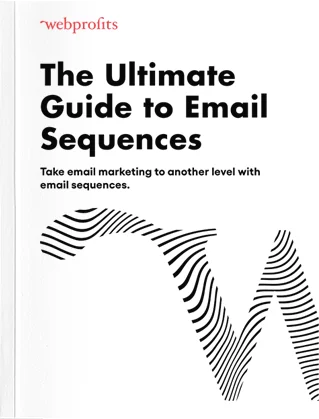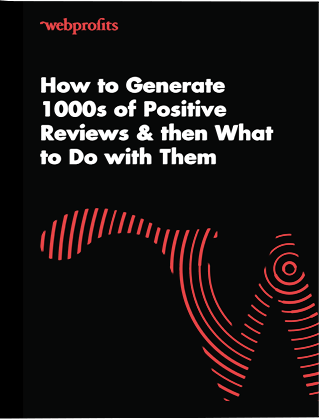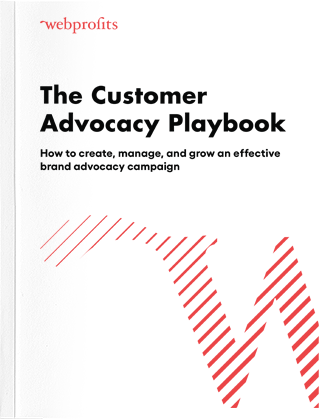How to generate reviews
This video on how to generate reviews is a summary of Duncan’s epic guide to review generation and what to do with positive and negative reviews once you’ve got them which you can view here.
Transcript:
Hi, I’m Duncan Jones from digital marketing agency Webprofits and I lead our multi-channel growth marketing product.
Today I’m going to talk about how to generate reviews, which is something that seems pretty simple, but which a lot of brands are getting wrong.
A quick warning before I go on – if your product or service or your customer support sucks then you need to fix that before you start review generation. To get positive reviews you need product-market fit and genuinely happy customers and if you scale up before then you’ll get heaps of bad reviews.
So why do reviews even matter and are they worth your time and focus?
Well, there are stats everywhere, which show the impact of reviews with surveys and polls frequently finding the positive impact that they have on consumers, but rather than run you through all these just have a think – have you personally used reviews and have they influenced you to purchase before? My bet is yes you have.
The best way to show why reviews matter is through split testing to actually prove they have a positive impact and are worth generating. A good example of is a watch eCommerce company, which split test all of its watch pages and changed “why shop with us” to reviews from Trustpilot this increased their sales by 58% and there’s heaps of examples like that.
Another reason reviews are worth your time is that aggregation sites are starting to become channels in their own right. Productreview.com.au is one of the most popular review sites in Australia and is now becoming a place consumers turn to first to find reviews and it is now generating a substantial volume of leads and sales for our clients, which proves again that reviews matter.
So now that you’re convinced about reviews – how should you actually generate them? This is a three-part process:
- Getting the timing right
- Asking in the right way and through the right channels and lastly
- Pushing them to the right place to leave the review.
Timing
Firstly, timing. Getting the timing of when you ask for a review right is essential to not only get them to write a review, but to increase the chances of them writing a positive one.
Essentially you need to ask for a review when the customer is at the height of the customer excitement and generally this is at one of these three times:
- Immediately after purchasing your product or service
- Immediately after receiving the product or service
- Immediately after receiving the promised benefit from your product or service
The third one is definitely the best time to ask, but it’s also the hardest to identify for a lot of companies.
To work out this out you could:
- See when organic reviews were posted and compare it to when they became a customer
- Split test different times to find out which time works best
- Use surveys and polls and also review any NPS surveys you’ve run in the past and see if there is a common time that people are at their happiest.
- You could review your competitors who are the most successful in getting reviews and see when they are asking
- Plus you can actually speak to your customers to get insights.
If you’re still not sure on timing you’ll either need to manually work this out for each customer or you can use industry or generic stats that review aggregation sites sometimes put out that detail the best times to ask.
Once you’ve worked out the best time – you actually need to ask for the review.
There have been a lot of studies conducted that show that simply asking for reviews will give you much higher ratings than not and that’s because generally it’s your unhappiest customers who will leave unprompted reviews.
Asking
So how should you ask?
- Firstly – you should be specific and simply ask them for a review and a star rating. Make sure not to ask a lot of questions, which will put a lot of people off due to the effort involved – you are asking them a favour after all so make it simple.
- Secondly, you should personalise the review request with the specific product or service that they purchased – by the time you ask them they may have forgotten you.
- Thirdly, make sure to use a unique review request. A boring, templated request will be ignored, but one from a personal, reliable email address that is written using your brands unique voice is way more likely to get results.
A few other things you should include:
- A pre-framed opening line such as: “If you’ve had a good experience please help us out….”
- A reason why they should take the time to leave a review – i.e. “to help out people just like you.”
- How quick & easy it will be for them to fill it out. For example “it will take just 3 minutes.”
- And a way for them to contact you if they’re not happy – you don’t want their only way to vent to be to leave you a review.
Another thing to note is you can ask multiple times so don’t be afraid to ask more than once – they might not have seen the first request or they may not have had time then.
There are a lot of different mediums you can actually ask for the review through and ideally you should ask via more than one. The most common ways to ask are:
- Email – which is the standard way brands ask for reviews and probably the most effective and this can be automated or manually sent if you’ve got high value clients.
- SMS – which a lot of brands, especially local ones, are now asking for reviews via and which is pretty effective due to high open rates.
- Push notifications – If you have an app you can use push notifications to get reviews, which is something that Google Maps has now started doing.
- Facebook and Google ads – which you can target only to specific buyer segments – for example, only your top customers a certain time after they’ve bought.
- Offline – If you’re an eCommerce store or service based business you should definitely make sure you use offline ways of asking for reviews such as a card or a letter in each package that you send.
- Phone calls or in person – Asking for a review over the phone or in person will have a much better close rate as it’s a personal request and not many people are going to leave you a bad review with you looking over their shoulder.
Once you’ve decided on the timing and what mediums you’re going to use to ask for reviews the next step is automating the review request as it can be very painful to continually send manual review requests and is something that will eventually drop in your priorities as you get busy.
If you can set-up an online trigger for the time your customer is at the height of their excitement (for example, the days since they purchased) then you can automate the review requests.
There’s a number of different third party tools, and some of these include:
- Email providers – which offer automated sequences that can be triggered quite easily.
- YOTPO – a tool for eCommerce websites, which personalises and automates review requests.
- Feedback Genius – which automates review requests for Amazon sellers.
- Burst SMS – which can automate SMS messages via API and has lots of other features.
- ManyChat – which can automate Facebook messenger review requests.
- Plus there’s even ways to automate direct mail straight from your CRM, which in the US can even be handwritten for you.
If you can’t set up an online trigger (for example, because your CRM system won’t integrate with your email system) then you will have to manually trigger review request emails.
This can still be sort of automated though, essentially you should just create an email sequence, which sends when people are manually added to the list. And then upload the customer emails whenever you want to trigger an email to them. This will save you recreating the email every time.
You can also use the platform’s direct tools to manually send review requests, for example Product Review offers businesses the ability to upload emails manually and trigger review request emails to them – the only downside of this is they are pushing reviews to just their platform.
Pushing
So now that you know when you’re going to send the review request and what you’re going to say plus you’ve setup a way to automate the process you need to decide where you actually want your customers to leave the reviews and this is something I see most brands getting wrong.
Unless you’re a review collation website, do not push reviews straight onto your website – there is so much more value getting them placed onto other websites and you can always transfer them back to your website later on.
Firstly, create a “Reviews” page on your site where you offer customers a range of platforms that they can leave reviews on. So that they can pick the one that they’re most comfortable with.
This page should be where review requests regardless of medium send people to so that you can optimise and improve it over time.
Once you have enough positive reviews on one of the platforms you can temporarily remove it from your list so that the others get more focus.
Before selecting the platforms you want to use, make sure you actually try leaving a review yourself. If it is a long, complicated sign-up process, avoid it – you don’t want any friction for the person leaving the review.
Also make sure to send people through directly to the form for each site, not to the homepage as it will be a hassle to find your company homepage.
In Australia the review sites I’d recommend you focus on first are:
- ProductReview – Which is the biggest, most well known review platform. It has great SEO, a brand, and will bring you both traffic, leads and sales.
- Facebook – If you get a positive review on Facebook that customer’s friends will all see it which is great advertising. Company pages are also checked by consumers regularly so it’s well worth having a good rating on.
- Google – Ratings on Google will help you rank for local searches and will be shown to prospects in Google products.
- Local directories – like True Local, Yelp and Word Of Mouth can work really well. Just make sure you add all of your addresses and locations separately to maximise the traffic and the reviews you get.
- Amazon and eBay – If you’re an eCommerce company that’s selling on those platforms you should definitely be pushing reviews onto there. It will help you rank and it will help your conversion rates.
You’ll notice I left Trustpilot and Feefo off the list and while they’re popular and okay websites for review aggregation they do not get as much targeted organic traffic compared to sites like ProductReview and thus shouldn’t be your first sites to focus on in my opinion.
Along with the big sites, make sure you also look for niche review sites for your business – there’s plenty of them around and you can easily find them by searching for your service or product and then “review” (for example, “broadband review”) or you could search for your competitors to see where they are listed (for example “Competitor Name reviews”).
Just make sure to check how many reviews are on the site to make sure it is popular before selecting it to focus on.
In summary, you need to do the following 3 things to generate reviews:
- Identify the time that the customer will be most happy with the product or service that they received.
- Ask the customer to leave a review and ensure it is an automated process if possible so it can scale as you grow.
- Push the customers that are happy to give you a review to the platforms that will give you the most visibility, traffic and sales.
Just asking for reviews is way better than doing nothing so get started as soon as you can and you’ll soon start to see your review count and star ratings increase and the marketing benefits associated with that.
If you’re still watching and would like to get access to some hacks that will take your review generation process to the next level simply comment HACKS and I’ll send you a link to 9 of my favourite ones.
That’s it for now. Thanks for watching.













hacks